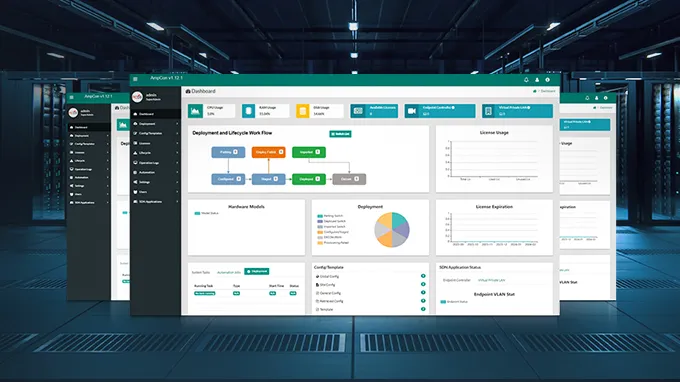OEO Media Converter in WDM System
The evolution of Wavelength Division Multiplexing (WDM) systems has been driven by the imperative to enhance the capacity of individual fibers, reflecting the escalating volume of network traffic and the growing demand for expanded bandwidth. OEO media converters play a pivotal role in this progression by facilitating the conversion of incoming optical signals into precise ITU-standard wavelengths for multiplexing. As integral components of CWDM and DWDM systems, OEO media converters are instrumental in ensuring the interoperability and efficiency of modern network infrastructures. This article aims to provide an in-depth exploration of the OEO-based WDM system and its significance in contemporary networking environments.
What’s OEO Media Converter?
OEO media converter, also known as a WDM transponder or wavelength converter, is an optical-electrical-optical (O-E-O) device designed specifically for wavelength conversion. This technology performs an O-E-O operation to convert wavelengths of light effectively. The FS WDM transponder series offers a diverse range of solutions tailored to meet various network requirements. Leveraging advanced O-E-O technology, FS converters ensure seamless wavelength conversion, resulting in enhanced network performance and efficiency.

Figure 1: What Is An OEO Converter
The transponder can convert Ethernet signals into a corresponding wavelength in CWDM and DWDM network infrastructures. From left to right, the CWDM/DWDM transponder receives an optical bitstream operating at one particular wavelength. And then it converts the operating wavelength of the incoming bitstream to an ITU-compliant wavelength and transmits its output into a CWDM or DWDM system. On the receiving side (right to left), the process is reversed.

Figure 2: Signal Conversion Inside an OEO Media Converter
Working Principle of OEO Media Converter
OEO media converter realizes wavelength conversion based on the Optical-Electrical-Optical transformation technology. Firstly, the OEO optical transponder receives the optical signals and converts them into electrical signals through the Optical-Electrical conversion. And then, the 3R technology (re-amplifying, re-shaping, and re-timing) is used to handle the signals. At last, electrical signals are modulated to the optical laser and then output. By this process, optical signal transmission distance therefore can be longer than before. As shown in the figure below, by using the media converter, the transmission distance reaches up to 40 km.

Figure 3: Working Principle of OEO Media Converter
What’s the Function of Wavelength Converter?
Besides the wavelength conversion, CWDM/DWDM transponders can also be deployed in the seamless integration of different fiber types by converting multimode fiber to single-mode fiber, dual fiber to single fiber. It can also be used as a repeater to convert the weak optical signals from the fiber into electrical signals and regenerates or amplifies, then recovers them into strong optical signals for continuous transmission.
Wavelength Conversion
As we all know, when adding a CWDM or DWDM Mux/Demux into a WDM network, there is a requirement to convert the optical wavelengths like 850 nm, 1310 nm, and 1550 nm to CWDM or DWDM wavelengths. Then the OEO transponder comes to assist. Wavelength conversion is the most common function of the OEO media converter.
Fiber Mode Conversion
In general, multimode fiber (MMF) is used for short-distance transmission while single mode fiber (SMF) is used for longer-distance transmission. If our network equipment is designed with a multimode port, but we want to achieve longer transmission distance only single mode fiber can achieve, then we need OEO media converter to complete mode conversion.
Fiber Count Conversion
Dual fiber transmission and single fiber transmission are two transmission modes applied in the network. Depending on the type of equipment and the fiber installed facility, dual fiber to single fiber conversion is required sometimes. OEO media converter can be used to solve this problem.
Clock Recovery and Signal Synchronization
OEO converter leverages clock recovery options to handle degraded signals, optimizing signal quality and ensuring data synchronization in the electrical domain to prevent loss or errors. Additionally, they act as repeaters in long-distance transmissions, extending network reach by converting wavelengths and amplifying optical power. Simultaneously, they convert weak optical signals into electrical signals, regenerating or amplifying them to ensure continuous signal transmission. Hence, OEO converters are also referred to as OEO fiber repeaters.
How Should We Choose OEO Media Converter?
Compatibility Check
-
Ensure the media converter is compatible with both half-duplex and full-duplex systems.
-
Some switches may operate in half-duplex, potentially causing data loss if the converter only supports full-duplex.
Connection Testing
-
Conduct thorough connection tests between fiber optic splices and the converter.
-
Incompatibility between converters could lead to unstable transmission and data loss.
Temperature Verification
-
Verify the operating temperature range for proper functionality.
-
Understanding temperature limits is vital, especially in high-temperature environments.
Security Implementation
-
Equip the converter with security devices to safeguard data integrity.
-
Protecting against security threats is crucial for network communication confidentiality.
Conclusion
In today's network communication landscape, where optical communication is paramount, OEO media converters emerge as indispensable components of WDM systems. By converting optical signal wavelengths and multiplexing them into ITU-standard wavelengths, these converters play a vital role in enhancing the flexibility and accessibility of CWDM and DWDM systems. This article serves as an introduction to the core concepts of OEO-based WDM systems, providing insights into the principles, functionalities, and practical applications of OEO media converters. When selecting the appropriate OEO media converter, it's essential to consider your specific needs and opt for a reputable supplier offering tailored solutions.
You might be interested in
Email Address

-
PoE vs PoE+ vs PoE++ Switch: How to Choose?
May 30, 2024













